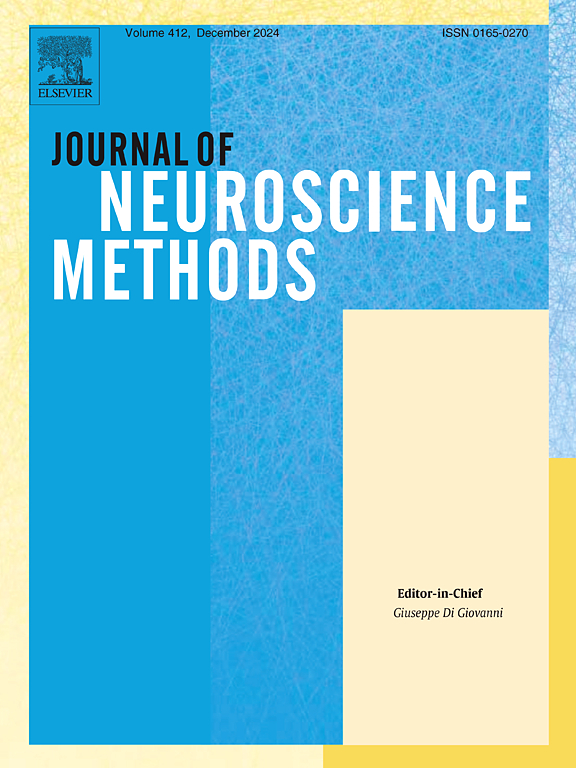同基因Fischer/F98胶质瘤模型中部分肿瘤切除的详细特征
IF 2.7
4区 医学
Q2 BIOCHEMICAL RESEARCH METHODS
引用次数: 0
摘要
脑肿瘤临床前模型在理解肿瘤生物学和制定抗肿瘤策略方面发挥着重要作用。然而,临床前研究评估了它们在未事先切除的肿瘤模型中的潜在治疗作用。然而,最大限度的安全切除是胶质母细胞瘤(GBM)临床治疗的第一步,已知对辅助治疗有显著影响。因此,我们描述了两种技术在F98胶质瘤大鼠中进行肿瘤切除,使该模型更接近临床环境。65只动物被分为5个不同的组:对照组,导管(直径1.74 mm)和活检穿孔(直径1.5/ 2.5/ 3 mm)。肿瘤植入后第10天,第11天处死部分动物用于组织学分析,其余动物用于生存估计。结果生存组所有动物经肿瘤切除后均复发。H&;E组织学切片可见切除空腔。对照组和切除组在生存率方面没有显著差异,但随着工具直径的增加,生存率有提高的趋势。与现有方法的比较很少有研究调查肿瘤切除模型的发展,但大多数这些技术需要复杂的设备。据我们所知,我们是第一个使用fisher - f98胶质瘤模型开发易于执行的部分肿瘤切除模型的人。结论我们详细描述了肿瘤的切除过程和复发模型,这为研究GBM治疗的局部递送策略提供了可能。本文章由计算机程序翻译,如有差异,请以英文原文为准。
Detailed characterization of partial tumor resection in the Syngeneic Fischer/F98 Glioma Model
Background
Preclinical models of brain tumors play a fundamental role in understanding tumor biology and deploying anti-tumor strategies. However, preclinical studies evaluate their potential therapy in tumor model without prior resection. Nevertheless, maximal safe resection, the first step in the clinical treatment of glioblastoma (GBM), is known to have a significant effect on adjuvant treatments.
New method
We have therefore characterized two techniques to perform tumor resection in F98 glioma-bearing rats to bring this model closer to the clinical context. A total of 65 animals were assigned in 5 different groups: control, catheter (1.74 mm diameter) and biopsy punch (1.5/ 2.5/ 3 mm diameter). On day 10 post-tumor implantation, some animals were sacrificed on day 11 for histological analysis whereas the remaining animals were used for survival estimates.
Results
All animals in the survival groups that underwent tumor resection recurred. The resection cavities were visible on the H&E histological sections. No significant difference was observed between the control and resection groups in term of survival but there was a trend towards improved survival with increasing tool diameter.
Comparison with existing methods
Few studies have investigated the development of tumor resection models, but the majority of these techniques require sophisticated equipment. To our knowledge, we are the first to develop an easy-to-perform partial tumour resection model using the Fischer-F98 glioma model.
Conclusions
Here we present a detailed characterization of the tumor resection procedure and recurrence model, which has potential for the investigation of local delivery strategies in the treatment of GBM.
求助全文
通过发布文献求助,成功后即可免费获取论文全文。
去求助
来源期刊

Journal of Neuroscience Methods
医学-神经科学
CiteScore
7.10
自引率
3.30%
发文量
226
审稿时长
52 days
期刊介绍:
The Journal of Neuroscience Methods publishes papers that describe new methods that are specifically for neuroscience research conducted in invertebrates, vertebrates or in man. Major methodological improvements or important refinements of established neuroscience methods are also considered for publication. The Journal''s Scope includes all aspects of contemporary neuroscience research, including anatomical, behavioural, biochemical, cellular, computational, molecular, invasive and non-invasive imaging, optogenetic, and physiological research investigations.
 求助内容:
求助内容: 应助结果提醒方式:
应助结果提醒方式:


